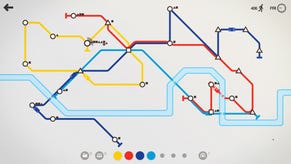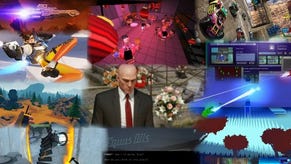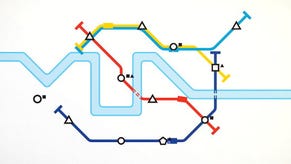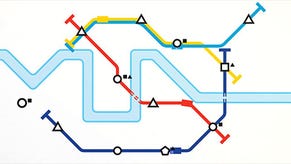Impressions: Mini Metro
Mornington Crescent
Sounds like an old British car, is in actual fact about designing underground rail systems. Basically, if you'd rather not play anything to do with transport, walk away now.
No, no, hey, come on, I didn't mean that, let's sit down and talk about this. I didn't really want to play anything to do with transport either, but I'm glad I did. Mini Metro is about subway systems, but it isn't really about subway systems.
It is! It totally is! But it isn't about being a train gonk, it's about movement. It's about creating and maintaining movement. It's about tranquil coloured lines, flowing neatly and being coolly reshaped into better flows still. It's about going "bollocks, if I only I could stretch the red line over that river then a thousand people stuck waiting on that station over there wouldn't want to kill me."
It's my favourite game about stretchy lines in a very long time. And I say that even though there's no damn sound, which on the one hand is extremely distracting, but on the other encourages me to seek out my own, appropriate minimalist, ambient or otherwise dancing-around-the-candles-at-Glastonbury-at-5am soundtrack. Line-stretching is all that's involved, other than occasionally adding extra carriages or locomotives to particularly busy stretch lines - the rest of the simulation plays itself. On paper, it sounds like there's little to do; in practice, it's moment-to-moment anxiety.
What it also does is make me think upon how many times I've sworn at unseen, nameless creators of the London Underground, damning their crazed logic for how it's caused my journey from Grotty, Overcrowded Tube Station X to Grotty, Eerily Deserted Tube Station Y to take 20 minutes longer than it surely needs to. As I make mistakes and compromises in my own tube layout, as I frown at how I've inadvertently I've made the people on the blue line have to tour the entire perimeter of the system simply to reach a stop that's basically just across the road from where they started, my annoyance at those ancient architects turns only to sympathy. Then it becomes panic, as a new stop pops into being which requires a wholescale rethink of my entire transport system if I'm to fold it into my fragile network.
What's particularly intriguing is that my layouts broadly come to resemble the London Underground's layout, and I don't know if that's because London is a geographic puzzle that logically can only be solved a certain way, or because my own memories of the place are affecting which coloured lines I place where, and in which shapes.
(Other cities are available, by the way, including Paris, New York and St Petersburg, with many more to come as Early Access rolls on, but broadly you're having the same experience no matter which country's public transport you choose to ruin. This is, for my money, Early Access done right. Mini Metro's essential challenge and essential appeal is there, it's solid, it's smart and it turns a dry concept into a mesmerising challenge of logic and aesthetics. Sound and more cities and maybe a few new ways to lay a line can come later: what matters is there right now.
Mini Metro is very much a game you learn as you play, both in terms of how to actually control the thing, and how to be any good at it. I'm still stranded somewhere out in Zone 4 in terms of the latter, but the former didn't take too long. Disaster is always waiting somewhere down the line, but I appreciate how beautifully Mini Metro turns to chaos. The black squares and triangles which denote passengers waiting at stations gradually increase in number, and a grey circle begins to fill at the busiest stops. If that circle fills, you've failed.
Basically, you've got a Clapham Junction, and no-one wants that. More likely though, you've got two or three Clapham Junctions. The wannabe passengers saying nothing, do nothing other than wait, but their impatience is palpable. It's sympathy, perhaps: I've been in their weary shoes too many times myself. What to do? Wait it out in the hope this stage of the challenge will end, rewarding me with another line, train, carriage or tunnel, or take action before it's too late?
Panic. Too many bodies, not enough choo-choos to carry them where they want to go. Dilemma. A minor adjustment to my elaborate network, or hit pause, tear down every line and start again to try and remove the choke points? Too late: it's all over. Too many waited for too long.
A game that's elegant even in disaster: just a few dots were all I needed to know everything had gone to hell, and just a few dragged lines were all that would ever have been needed to fix it. The spirit and the ingenuity of transportation management games of times past, preserved and even strengthened despite chopping away everything beyond 'where does each train go?'
So I find myself in a rare situation: hoping that an Early Access game doesn't expand too much further. Too many parts stacked on top of this cool, clean Jenga tower could upset its admirable minimalism, distract from its essential challenge of flow. What's already here suggests a game that's too smart and clear-eyed to fall into that trap. Whatever it might go in the future, it is most certainly ready to depart the station right now.
Mini Metro is out now on Steam Early access and the Humble Store, and so far has been receiving a steady stream of updates. Audio is promised soon, and the Zen mode Graham called for when he wrote about it a while back is already in there. The original prototype game jam version is available to fiddle with for free too.












